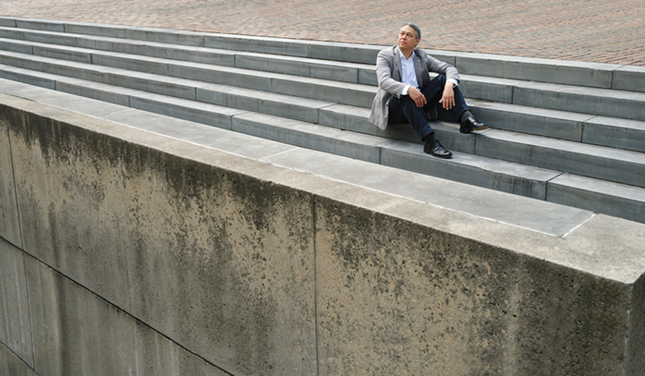
Chris Buck

Chris Buck
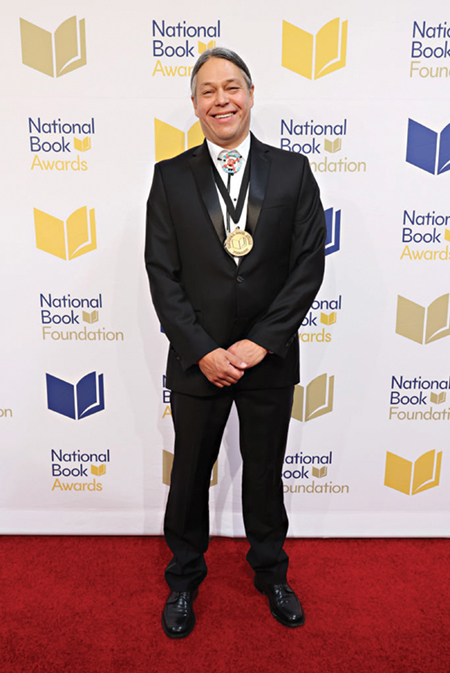
Cindy Ord/Getty Images
Ned Blackhawk is shown here attending the 74th National Book Awards at Cipriani Wall Street on November 15, 2023. His most recent book, The Rediscovery of America, Native Peoples and the Unmaking of U.S. History, won the National Book Award for nonfiction.
View full image

Cindy Ord/Getty Images
Ned Blackhawk is shown here attending the 74th National Book Awards at Cipriani Wall Street on November 15, 2023. His most recent book, The Rediscovery of America, Native Peoples and the Unmaking of U.S. History, won the National Book Award for nonfiction.
View full image
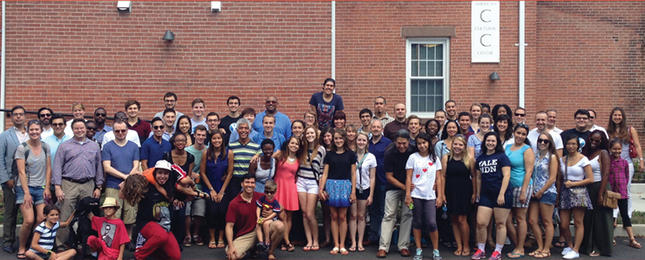
Courtesy Ned Blackhawk
Early each fall, Yale’s Native American Cultural Center hosts a “welcome back” event, including a cookout and a community photo. (The one above is in 2014.) Professor Blackhawk, close to the middle of the front row of the photo, is standing alongside his daughter Eva, then 12 years old.
View full image

Courtesy Ned Blackhawk
Early each fall, Yale’s Native American Cultural Center hosts a “welcome back” event, including a cookout and a community photo. (The one above is in 2014.) Professor Blackhawk, close to the middle of the front row of the photo, is standing alongside his daughter Eva, then 12 years old.
View full image
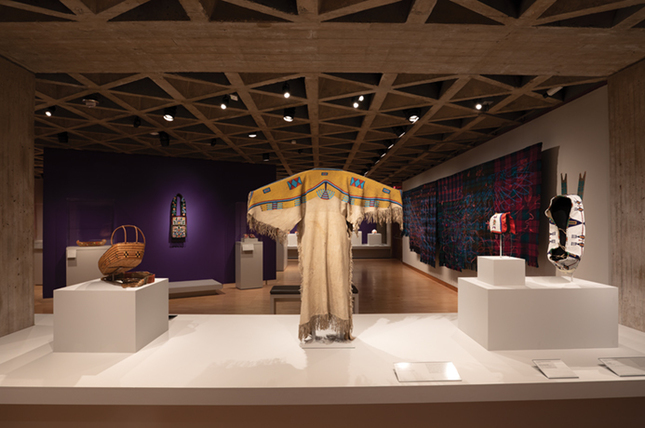
Yale University Art Gallery
This student-curated exhibition, “Place, Nations, Generations, and Beings: 200 Years of Indigenous North American Art,” included objects from the Yale Peabody Museum of Natural History, the Beinecke Rare Book and Manuscript Library, and the Yale University Art Gallery. Organizers decided to limit the use of glass cases to present the pieces as community members may have used or seen them. The exhibit, at the University Art Gallery, ran from the fall of 2019 to the winter of 2021.
View full image

Yale University Art Gallery
This student-curated exhibition, “Place, Nations, Generations, and Beings: 200 Years of Indigenous North American Art,” included objects from the Yale Peabody Museum of Natural History, the Beinecke Rare Book and Manuscript Library, and the Yale University Art Gallery. Organizers decided to limit the use of glass cases to present the pieces as community members may have used or seen them. The exhibit, at the University Art Gallery, ran from the fall of 2019 to the winter of 2021.
View full image
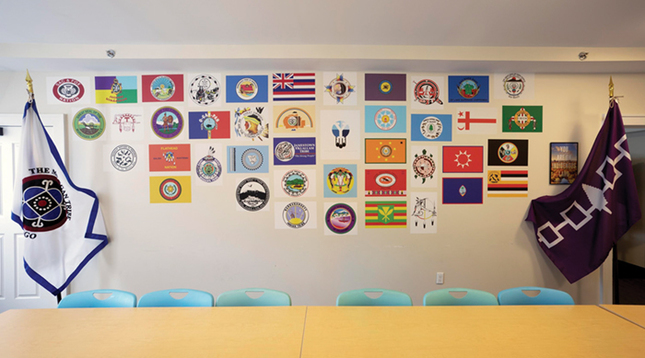
Courtesy Ned Blackhawk
The “Wall of Nations” is in the first-floor seminar room of Yale’s Native American Cultural Center. Nearly 70 Native American and Indigenous community tribal flags are now on the wall. Each flag represents campus
community members who have asked to have their flags included.
View full image

Courtesy Ned Blackhawk
The “Wall of Nations” is in the first-floor seminar room of Yale’s Native American Cultural Center. Nearly 70 Native American and Indigenous community tribal flags are now on the wall. Each flag represents campus
community members who have asked to have their flags included.
View full image
After a stint in the Navy, Aaron Bird Bear arrived in Seattle as an undergraduate at the University of Washington, where he studied physical oceanography, quantifying circulation patterns in the oceans and the interplay of those patterns with the atmosphere. The major required a lot of math and physics, which meant he had little time, and, frankly, little interest, in most social science and humanities classes. But he couldn’t entirely avoid them. In the spring of his senior year he enrolled in a course on the comparative history of ideas. That’s where he met Ned Blackhawk, a doctoral student in the history department who came to give a guest lecture.
“He was critically examining the movie Dances with Wolves,” Bird Bear says. If you don’t remember, Dances with Wolves, which came out in 1990 and featured Kevin Costner’s prominent mustache, was nominated for 12 Academy Awards and won seven, including Best Picture. It is credited with reviving the western, a genre that Hollywood had come to view as a losing bet. “The movie took the world by storm, and Ned was reminding us that, for the most part, Dances with Wolves was a white love story with Native Americans as set pieces. It was two white people falling in love. I hadn’t before that day seen a lot of long-haired Natives as lecturers on campus.”
Bird Bear is Mandan, Hidatsa, and Diné—whom the Spanish called Navajo—but only enrolled with the Three Affiliated Tribes. The traditional homelands of these tribes spread across the Missouri River in North and South Dakota. Blackhawk is a member of the Western Shoshone, who traditionally lived in what are now central Nevada, northwestern Utah, and the Death Valley region of southern California.
Bird Bear approached Blackhawk after the lecture and introduced himself. They were both urban Indians who had spent much of their childhoods in cities, and Blackhawk was at the university to work with Richard White, one of the country’s leading scholars of Native American history.
This was the mid-nineties, a time when “Native American history scarcely existed as a field,” according to Nicole Eustace ’94, a professor of history at New York University. Most studies of Indigenous peoples had until then been carried out in anthropology departments, where Native people were more objects of study than subjects themselves. Lecture courses on colonial US history, if they mentioned Native Americans at all, gestured toward their presence in the margins, “and it was likely something vaguely Thanksgiving-related,” Eustace says.
Though the field has since developed, the problem of how American history incorporates Native Americans remains as enduring as it was 30 years ago. Only in the past few years, for instance, did museums of natural history turn a critical eye to dioramas containing Native Americans. Not only do these displays tend to perpetuate racist stereotypes and incorporate Native objects without the consent of tribal nations, but, more abstractly, they cast Native Americans as ahistorical objects of science, occupying englassed worlds akin to those of neighboring saber-toothed cats and giant sloths.
“That myth has died very, very, very slowly,” Eustace says. “But its death happened in part because Ned came along to say there is a history here that has actors, that has ideas, that has a material basis and political turning points that we can trace through time.”
The integration of Native Americans into a narrative of America originally constructed around their absence has been Blackhawk’s project since he was in graduate school. Starting with his dissertation, which turned into his first academic book, Violence over the Land, he has been intent on centering Native Americans as a force not just shaped by, but shaping the creation of America—a country whose emergence, he says, is impossible to understand without a full record of its Indigenous past. Nor is this claim made exclusively about that early historical period to which Native Americans are so often confined: when the Puritans arrived on Atlantic shores, when frontier families spread across the continent, when the federal government claimed their land and funneled them on to reservations. Blackhawk, the first tenured Native American at Yale in the 323 years since its founding, places Native peoples at the cynosure of our country’s modern epochs, including the Constitutional Convention, the New Deal, and the Cold War.
“Ned’s goal is to reinterpret American history,” says White, his doctoral advisor and now a professor emeritus at Stanford. “It’s not a minor task, and it has taken a long time.”
This project of reinterpretation led to the publication of Blackhawk’s most recent book, The Rediscovery of America, which won the 2023 National Book Award for nonfiction. The book stitches a generation of Native American scholarship together into a monumental survey that begins with Spanish imperialists of the sixteenth century and concludes with President Clinton. The work is constructed not as a story of discovery—Europeans discovering a land or a people—but of encounter, and Blackhawk traces the reciprocal effects of these encounters as they create the sedimented foundation of a new country.
“I was a little surprised at the scope of the book when I first learned what he was attempting to do,” says Brenda Child, a professor of American studies at the University of Minnesota and a member of the Red Lake Ojibwe Nation, which once controlled much of what is now northern Minnesota. “For Ned to put Native history into all of American history, to say they are at the center of this narrative, is a very brave thing to do.”
The Rediscovery of America is filled with facts that remain startling despite their general familiarity: Native peoples were not granted US citizenship until 1924. Government-sponsored campaigns of child removal from reservations resulted in the forcible relocation of 40 percent of Indian children to boarding schools. North America’s population nearly halved between 1492 and 1776, and on the Spanish colony of Hispaniola, home today to the Dominican Republic and Haiti, a population of roughly three million Indigenous people in 1493 was reduced over the next half century to a mere 500. “The Spanish conquest was simultaneously a holocaust,” Blackhawk writes.
Some of the facts are shocking for their relative obscurity. The South American silver mining city of Potosí was, in the 1500s, one of the largest cities in the world, a boom town, equivalent in size to London or Paris, that was fueled by the labor of Indigenous people. The mines in the region may at one point have produced 60 percent of the world’s silver, which was shipped overseas on galleons and used to mint Spanish pesos, French pences, and English pennies. In this way, Blackhawk notes, Indigenous forced labor underpinned the expansion of mercantile commerce across Europe. More broadly, nearly one million Native Americans were enslaved across the Americas, many of them shipped east from ports in Boston and Charleston. It wasn’t until 1715 that more enslaved Africans were imported than enslaved Indigenous people were exported.
And some of the facts Blackhawk presents are marshaled in ways that completely upend our understanding of pivotal moments in American history. Take the Revolution, which through repeated storytelling has emerged as a purified elixir of the American spirit, an event that embodies like no other the ideals of equality and liberty. It represents the noble crafting of democracy in the shadow of monarchy.
Great minds in meetinghouses, oppressed citizens longing for self-determination—together they forged a new kind of government.
Blackhawk, rather, takes pains to argue that of the 27 grievances detailed in the Declaration of Independence, the last one, the one that is almost never mentioned—not taxation without representation, not the forced billeting of troops, not tariffs—is, in fact, the most important one. It accuses the Crown of inciting “domestic insurrection” by “the merciless Indian Savages.”
This grievance, Blackhawk goes on to explain, was a response to interior skirmishes between settler militias and both British troops and Native tribes. At the conclusion of the Seven Years War, in 1763, France ceded its territory to Great Britain and Spain, and the British, in turn, demanded that settlers not expand west of the Appalachians. This contentious declaration was designed to secure fragile economic and political alliances with interior tribes. Many on the frontier, however, viewed it as a form of appeasement. Militia groups like the Paxton Boys of Central Pennsylvania fomented local insurrection to break those peaceful ties.
Studies of America in the 1760s and 1770s that don’t account for relations with Native Americans, particularly those predicated on frontier violence, “fail on a fundamental level to understand concomitant anti-Indigenous currents also at play during the Revolutionary era,” Blackhawk explained during a conversation at the Massachusetts Historical Society. In this way, as much as the events of 1776 were against the British Crown, they were also for the taking of Native lands. If the Revolution had aspired to lofty ideals, it was equally rooted in earthly avarice.
Blackhawk dedicated his first academic book to his father, “who showed me that one need not live a life in pain.” That was partly in recognition of the difficult life his father had led, including leaving his ancestral homelands for a job in the distant city. His father did not let pain—his own, that of past generations—define him.
Blackhawk grew up on the west side of Detroit near Six Mile Road. His father, who is Western Shoshone, was a social worker, his non-Native mother an English teacher. He was an only child who spent time by himself watching sports and reading Our 50 States in order to memorize geographical facts like the area of each state or its total population. He rode a paper route delivering the Detroit Free Press. To his knowledge, his was the only Native family in the neighborhood; he was the only identifiable Indian throughout most of his education.
At 18, he took the bus to Montreal to begin his freshman year at McGill University. He had a general interest in global affairs, but he was not committed to any major, nor did he know what to expect at a Canadian school. “But the strangest experience was how some of the things I thought I was leaving behind in America kind of followed me,” he says. McGill’s male sports teams were the Redmen. Their mascot was an Indigenous man wearing a feathered headdress.
In the summer after his freshman year, tribal opposition to the expansion of a golf course in the ancestral burial grounds of the Kanesatake, about 40 miles west of Montreal, led to a 78-day standoff between three Mohawk communities and the Quebec police, the Royal Canadian Mounted Police, and, ultimately, the Canadian Army. As the confrontation expanded, members of the Mohawk tribe took over a municipal building. Indigenous warriors occupied the Mercier Bridge, cleaving a key route that connected Montreal to its southern suburbs. The Canadian media were riveted. At the protest’s conclusion, a 14-year-old Indigenous girl, clutching the hand of her four-year-old sister, was stabbed by a soldier’s bayonet. The picture of her on the ground, screaming in anguish and terror, protectively embracing her sister with one arm and with her other grasping the hand of a soldier in fatigues, had at last solidified in image the centuries-old plight of Indigenous communities across the country. If this event could not quite inspire a wholly new Canadian consciousness, it at least destabilized the old one.
Something new, or perhaps long hidden, turned over in Blackhawk as he watched this event unfold. He began a twinned intellectual and personal exploration of Native American history. He became active on campus, helping to form a Native Awareness Coalition. He worked to get the Redmen’s mascot changed. (The name remained in place until 2019.) He organized a speaker series on Indigenous topics, went to rallies, supported the local Mohawk community, and applied to study history in graduate school.
He started his PhD at UCLA, but the professor he had applied to work with, Melissa Meyer, left the year that he arrived. Without her presence, the history department was, to put it generously, less than receptive to the research projects that Blackhawk wanted to pursue. Blackhawk left UCLA after receiving his master’s and found a new academic home in the University of Washington.
It was there that he lighted on his dissertation topic: an exploration of the important role that Indians of the Great Basin played in Western history. He focused on explicit narratives of violence and implicit narratives of pain—“elusive yet omnipresent,” he writes. He traveled to Santa Fe, where the archives held the journals of conquistadors, to unearth in detail the brutal treatment of Indigenous men, women, and children in a region that was also home to his ancestors, the Western Shoshone.
He would talk with Bird Bear sometimes about a growing concern that immersion in centuries of atrocities could somehow desensitize him, week by week uprooting the cords of empathy within, deadening his emotions. “This was unsettling him,” Bird Bear says. “I saw it, in part, as my job to cheer him up, to explain that there is this whole other world. There is not only the world of barbarity, violence, cruelty, but also one of frolic, fun, connection.”
To a degree, this worked. They partied together at powwows. They snowboarded in Santa Fe and outside of Madison, Wisconsin, where Blackhawk landed his first faculty position in 1999. It is so much more pleasant, after all, to ignore the trauma, to hide the horror.
The imprint of America’s violent past is unavoidable. As Bird Bear put it, Native Americans have no reason to watch zombie movies; they simply “step outside the front door and see that 99 percent of the people walking around are not Indigenous.” Their world is post-apocalyptic.
This makes victories small and large—the simple resilience inherent in survival—important to celebrate. In 2013, four years after Blackhawk was hired at Yale, he witnessed the opening of the Native American Cultural Center at 26 High Street.
For the first time, the organization had its own space: three floors and administrative staff dedicated to supporting the growing number of Native American and Indigenous students on campus. Blackhawk has helped develop and organize the Yale Indigenous Performing Arts Program, the Native American Language Project, the Yale Group for the Study of Native America, the Henry Roe Cloud Conference, and the Henry Roe Cloud Dissertation Writing Fellowship. (Roe Cloud was the first known Native American to graduate from Yale, in 1910.)
Blackhawk also supported the Yale Art Gallery’s exhibition of Indigenous North American art, which ran from 2019 through early 2021 and resulted in the hiring of Royce K. Young Wolf, the university’s first assistant curator of Native American art.
She holds a joint appointment between the Art Gallery and the Peabody Museum.
While the administration has been supportive of this work, students have been the driving force. Blackhawk would like to see Yale take a more active role in its commitment to Native American studies and communities. Dartmouth, he pointed out, offers its students a semester of study at the Institute of American Indian Arts in Santa Fe. The University of Wisconsin guarantees full scholarships to Wisconsin Native Nations students pursuing their first undergraduate degree. And Harvard Law School has a clinical partnership with the Native American Rights Fund. (Blackhawk himself has been party to Supreme Court amicus briefs and cofounded the American Indian Sovereignty Project, which he runs with his wife, NYU law professor Maggie Blackhawk.)
“I’ve been at Yale 15 years,” Blackhawk says. “I’ve seen this process moving forward and I also know that there is still a long way to go.” To put right 500 years of systematic injustice, discrimination, repression, disenfranchisement, dispossession, murder, forced assimilation, immiseration, and erasure to the point of invisibility will not be the project of one professor at one university. Blackhawk and his colleagues see themselves as just starting out on the much larger project of recrafting our national mythology. He likes to note that we are approaching July 4, 2026, the 250-year anniversary of the Declaration of Independence. What, he asks, will we be celebrating when the day comes?
 loading
loading
1 comment
-

Mary Robbins, 11:31am July 20 2024 |  Flag as inappropriate
Flag as inappropriate
The comment period has expired.Thank you, Professor Blackhawk and colleagues, Yale Alumni Magazine and article writer Dylan Walsh for sharing these truths so simply and forcefully. This article along with Professor Blackhawk's book "The Rediscovery of America" should be read as widely by Yale students (and all others) as William Cronon's "Changes in the Land" was read during my time at Yale School of the Environment in 1987 to 1989.